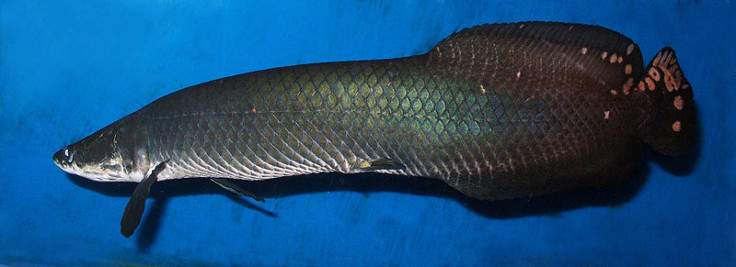Giant Amazon Fish Discovered In Brazil, First Arapaima Species Found In 160 Years [PHOTOS]

A new species of a giant Amazonian fish has been discovered in Brazil, according to scientists from the SUNY College of Environmental Science and Forestry.
The fish is an arapaima, an air-breathing fish native to the Amazon Rainforest rivers in Brazil that is typically 6 to 7 feet long. The new discovery marks the first arapaima species to be discovered since 1847, National Geographic reports.
"Everybody for 160 years had been saying there's only one kind of arapaima. But we know now there are various species, including some not previously recognized,” Dr. Donald Stewart of the SUNY College of Environmental Science and Forestry (ESF), who made the discovery, said in a news release.
The findings, published in the journal Copeia, reveal how Stewart identified the new species after examining preserved arapaima at the Instituto Nacional de Pesquisas da Amazônia in Manaus, Brazil. The new species, known as A. leptosome, is the fifth known arapaima species in existence.

Four species were identified in the mid-1800s, but it was in 1868 when Albert Günther, a scientist at the British Museum of Natural History, revised popular opinion and said all arapaima belong to one species.
"Until this year, no taxonomist has questioned Günther's opinion about these iconic fishes," Stewart wrote, explaining how he read the 19th-century literature on the giant fish and concluded there were four distinct species.
"Failure to recognize that there are multiple species has consequences that are far- reaching," Stewart said, pointing to how arapaimas are overfished, which could have detrimental consequences on their species diversity. “The bottom line is that we shouldn't be moving these large, predatory fishes around until the species and their natural distributions are better known. Given the uncertainties, precaution is needed."
The newly discovered A. leptosome has a slender body, distinct sensory cavities on the head, a sheath that covers part of the dorsal fin and a unique color pattern. It was originally caught in 2001 near the confluence of the Solimões and Purus rivers in Amazonas State, Brazil.
Dr. Leandro Castello, an authority on arapaima in Brazil, agrees. "Abundances of arapaima in large expanses of their natural habitat today are near zero, largely as a consequence of overfishing," Castello said. "The likely impacts of this magnitude of overfishing on species diversity are not good."
A specimen of the new species is currently on display at a public aquarium in the Ukraine. “I don’t know how it got there; someone most be culturing them and sent them to the Ukraine,” Stewart told National Geographic.
Stewart adds that the discovery might prompt future research on the giant fish. “Hopefully it will get more people in Brazil looking more closely at what’s swimming around out there,” he said.
© Copyright IBTimes 2024. All rights reserved.












